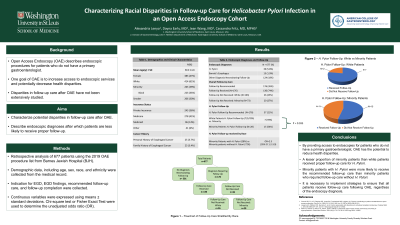Back


Poster Session B - Monday Morning
Category: General Endoscopy
B0287 - Characterizing Racial Disparities in Follow-Up Care in an Open-Access Endoscopy Cohort
Monday, October 24, 2022
10:00 AM – 12:00 PM ET
Location: Crown Ballroom

Has Audio

Alexandria Lenyo, BS
Washington University School of Medicine
St. Louis, MO
Presenting Author(s)
Alexandria Lenyo, BS1, Dayna Early, MD2, Jean Wang, MD, PhD2, Cassandra D.L.. Fritz, MD, MPHS2
1Washington University School of Medicine, St. Louis, MO; 2Washington University School of Medicine in St. Louis, St. Louis, MO
Introduction: Open-access endoscopy (OAE) describes access to endoscopic procedures for patients who are not office-established patients of a gastroenterologist. OAE has expanded access to endoscopy and can decrease healthcare disparities. Previous studies have explored factors associated with non-attendance to OAE. However, disparities in follow-up care after OAE have not been described.
Methods: Barnes-Jewish Hospital (BJH) is a large nonprofit hospital in St. Louis, MO. BJH offers OAE to the St. Louis community. Utilizing the procedure list for open-access esophagogastroduodenoscopies (EGD), we completed a retrospective analysis of all patients who received an open-access EGD during 2019. During this time, 677 open-access EGDs were scheduled. Demographic and clinical variables, EGD indication, EGD findings, recommended follow-up, and completed follow-up care were collected from the electronic health record. Means ± standard deviations (SD) were used to express continuous variables. Student’s t-tests were utilized to compare means. Chi-square test or Fisher Exact Test were used to determine the unadjusted odds ratio (OR) and 95% confidence interval. A two-sided p-value of < 0.05 was considered statistically significant.
Results: Of the 677 open-access EGDs, 294 (43.4%) were male, 414 (61.2%) identified as white, and 259 (38.3%) identified as minority. Within minority patients, 223/259 (86.1%) identified as Black. Some type of follow-up care was recommended in 176/677 patients (26.0%). Of the 176 patients who were recommended for follow-up, 130/176 (73.9%) were able to obtain the recommended follow-up. Of the 176 patients who were recommended for follow-up care, 37 (21.0%) were found to have HP. When stratifying the population who required some type of follow-up care by race, minority patients with HP were more likely than minority patients without HP to receive appropriate follow-up (OR=2.3; 95% CI 1.2 – 3.9). For white patients, those with HP were just as likely as those with a differing diagnosis to receive proper follow-up (OR 0.85, 95% CI 0.2 - 3.9).
Discussion: OAE has the potential to decrease healthcare disparities by providing access to endoscopies for patients who do not have a primary gastroenterologist. Minority patients with HP were more likely to receive the appropriate follow-up care than minority patients who required follow-up care without HP. Implementing strategies to ensure that all patients receive follow-up care after OAE, regardless of the findings made during OAE, is necessary.
Disclosures:
Alexandria Lenyo, BS1, Dayna Early, MD2, Jean Wang, MD, PhD2, Cassandra D.L.. Fritz, MD, MPHS2. B0287 - Characterizing Racial Disparities in Follow-Up Care in an Open-Access Endoscopy Cohort, ACG 2022 Annual Scientific Meeting Abstracts. Charlotte, NC: American College of Gastroenterology.
1Washington University School of Medicine, St. Louis, MO; 2Washington University School of Medicine in St. Louis, St. Louis, MO
Introduction: Open-access endoscopy (OAE) describes access to endoscopic procedures for patients who are not office-established patients of a gastroenterologist. OAE has expanded access to endoscopy and can decrease healthcare disparities. Previous studies have explored factors associated with non-attendance to OAE. However, disparities in follow-up care after OAE have not been described.
Methods: Barnes-Jewish Hospital (BJH) is a large nonprofit hospital in St. Louis, MO. BJH offers OAE to the St. Louis community. Utilizing the procedure list for open-access esophagogastroduodenoscopies (EGD), we completed a retrospective analysis of all patients who received an open-access EGD during 2019. During this time, 677 open-access EGDs were scheduled. Demographic and clinical variables, EGD indication, EGD findings, recommended follow-up, and completed follow-up care were collected from the electronic health record. Means ± standard deviations (SD) were used to express continuous variables. Student’s t-tests were utilized to compare means. Chi-square test or Fisher Exact Test were used to determine the unadjusted odds ratio (OR) and 95% confidence interval. A two-sided p-value of < 0.05 was considered statistically significant.
Results: Of the 677 open-access EGDs, 294 (43.4%) were male, 414 (61.2%) identified as white, and 259 (38.3%) identified as minority. Within minority patients, 223/259 (86.1%) identified as Black. Some type of follow-up care was recommended in 176/677 patients (26.0%). Of the 176 patients who were recommended for follow-up, 130/176 (73.9%) were able to obtain the recommended follow-up. Of the 176 patients who were recommended for follow-up care, 37 (21.0%) were found to have HP. When stratifying the population who required some type of follow-up care by race, minority patients with HP were more likely than minority patients without HP to receive appropriate follow-up (OR=2.3; 95% CI 1.2 – 3.9). For white patients, those with HP were just as likely as those with a differing diagnosis to receive proper follow-up (OR 0.85, 95% CI 0.2 - 3.9).
Discussion: OAE has the potential to decrease healthcare disparities by providing access to endoscopies for patients who do not have a primary gastroenterologist. Minority patients with HP were more likely to receive the appropriate follow-up care than minority patients who required follow-up care without HP. Implementing strategies to ensure that all patients receive follow-up care after OAE, regardless of the findings made during OAE, is necessary.
Disclosures:
Alexandria Lenyo: Abbott Laboratories – Stock-publicly held company(excluding mutual/index funds). AbbVie – Stock-publicly held company(excluding mutual/index funds).
Dayna Early: Guardant Health – Advisory Committee/Board Member.
Jean Wang indicated no relevant financial relationships.
Cassandra Fritz indicated no relevant financial relationships.
Alexandria Lenyo, BS1, Dayna Early, MD2, Jean Wang, MD, PhD2, Cassandra D.L.. Fritz, MD, MPHS2. B0287 - Characterizing Racial Disparities in Follow-Up Care in an Open-Access Endoscopy Cohort, ACG 2022 Annual Scientific Meeting Abstracts. Charlotte, NC: American College of Gastroenterology.

